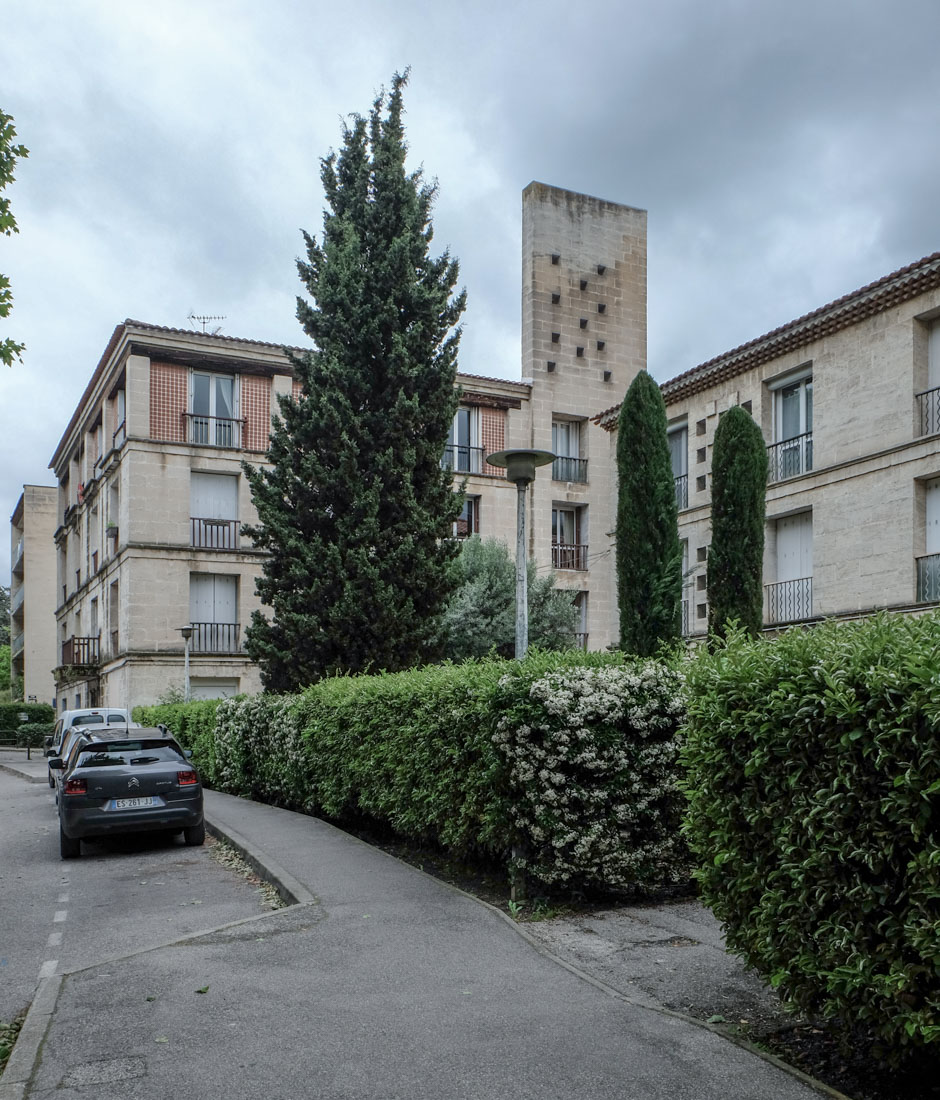 |
 |
 |
 |


Deux cent Logements
Avenue Jean Moulin, Aix-En-Provence
1951 - 1953
The architectural ensemble of the 200 apartments ("Deux cent Logements") in Aix-en-Provence was built between 1951 and 1953 during the reconstruction phase to counter the housing shortages. In the post-war period, migration flows from the countryside to the city had accelerated. Within a short time it was necessary to build large quantities of low-cost apartments. For the Housing Ensemble in Aix-en-Provence the motto was "200 apartments for 200 million within 200 days". Fernand Pouillon, who had already been heavily involved in the rationalization of construction sites in his earlier projects, won the contract. The city of Aix-en-Provence and the Ministry of Reconstruction had jointly commissioned the construction of the 200 apartments. They did not follow the usual logic of real estate development, but sought an optimal response to the housing needs of the community. In a special procedure, residents were offered 25-year lease-purchase contracts without own funds. The aim was to allow a broad middle class of the population access to home ownership.
The originality of the project designed by Fernand Pouillon lies in the combination of local traditional influences with modern technology. Fernand Pouillon was inspired by the urban proportions of Aix-en-Provence and the traditional buildings. The ensemble of "Deux cent Logements" consists of a group of five buildings spread out on both sides of the Rue des Alpes at the exit of Aix-en-Provence. The buildings were built on a square or rectangular ground plan. Each building is surrounded on the ground by a pebble floor, which ensures the drainage of rainwater. The buildings have a varied and rich decoration. There are, among others, ceramics by Philippe Sourdive in the entrance halls and on the facades of the square-plan buildings. With great care, the common external spaces were designed, organized around four small squares. Innovative was a principle used for the first time, in which the exterior walls of supporting natural stone were connected with the inner walls made of special bricks. In an approach typical for Fernand Pouillon, he tries to express modernity not through formal aspects but through innovative and efficient construction. Newer buildings later created in the neighborhod of this ensemble, testifying the influence of Fernand Pouillon on the architects of the region.
Das architektonische Ensemble der 200 Wohnungen ("Deux cent Logements") in Aix-en-Provence wurde in den Jahren 1951 bis 1953 während der Wiederaufbauphase zur Bekämpfung des Wohnungsmangels errichtet. In der Nachkrigszeit hatten sich die Migrationsströme vom Land in die Stadt beschleunigt. In kurzer Zeit galt es grosse Mengen an kostengünstigen Wohnungen zu bauen. Beim Wohnungsbau Ensemble in Aix-en-Provence galt das Motto "200 Wohnungen für 200 Millionen innerhalb von 200 Tagen". Fernand Pouillon, der sich bereits bei seinen früheren Projekten stark mit der Rationalisierung von Baustellen beschäftigt hatte, konnte den Auftrag für sich gewinnen. Die Stadt Aix-en-Provence und das Ministerium für Wiederaufbau hatten den Bau der 200 Wohnungen gemeinsam in Auftrag gegeben. Dabei folgten sie nicht der üblichen Logik der Immobilienentwicklung, sondern suchten nach einer optimalen eine Antwort auf die Wohnbedürfnisse der Gemeinschaft. In einem speziellen Verfahren wurden den Bewohnern 25-Jährige Miet-Kauf-Verträge ohne Eigenmittel angeboten. Damit wurde das Ziel verfolgt, einer breiten Mittelschicht der Bevölkerung den Zugang zum Wohneigentum zu erlauben.
Die Originalität des Projektentwurfes von Fernand Pouillon liegt in der Verbindung von lokalen traditionellen Einflüssen mit moderner Technik. Fernand Pouillon liess sich von den städtischen Proportionen von Aix-en-Provence und den traditionellen Gebäuden inspirieren. Das Ensemble der "Deux cent Logements" besteht aus einer Gruppe von fünf Gebäuden, welche sich auf beiden Seiten der Rue des Alpes am Ausgang von Aix-en-Provence verteilen. Die Gebäude wurden über quadratischem oder rechteckigem Grundriss errichtet. Jedes Gebäude ist auf dem Boden von einem Kieselboden umgeben, welcher die Ableitung von Regenwasser gewährleistet. Die Gebäude weisen eine abwechslungsreiche und reichhaltige Dekoration auf. Unter anderem gibt es Keramik von Philippe Sourdive in den Eingangshallen und an den Fassaden der Gebäude mit quadratischem Grundriss. Mit grosser Sorgfalt wurden die gemeinschaftlichen Aussenräume gestaltet, welche um vier kleine Plätze organisiert sind. Innovativ war ein erstmals angewendetes System, bei welchem die Aussenwände aus tragendem Naturstein mit den Innenwänden aus speziellen Backsteinen miteinander verbunden wurden. In einer für Fernand Pouillon typischen Herangehensweise versucht er Modernität nicht durch formale Aspekte sondern durch innovative und effiziente Bauweise zum Ausdruck zu bringen. Rund um dieses Gebäudeensemble sind später Bauten entstanden, welche vom Einfluss Fernand Pouillons auf die Architekten der Region zeugen.